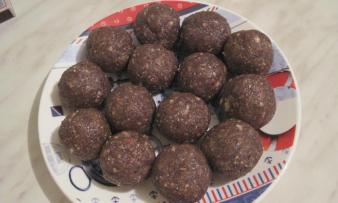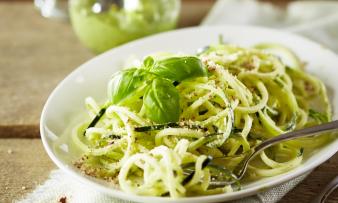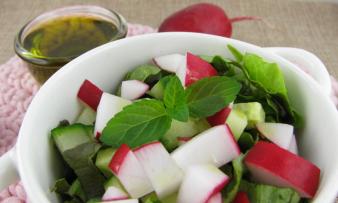Linoleic acid; LA; 18:2 omega-6
Conclusion:
As a result of using more cooking oil, vegans and vegetarians often consume an excess of omega-6 fatty acids. The ratio to omega-3 fatty acids is then even worse than in the case of omnivores. This can be fatal.
Our motto is to “eat natural whole foods.”
Incidentally, Erb Muesli has been developed to compensate for this poor ratio; it contains much larger amounts of “anti-inflammatory omega-3” than of omega-6, which produces arachidonic acid, an acid that promotes inflammation. The essential accompanying vitamins and minerals are also contained in this muesli.
Linoleic acid (LA) is an essential n-6 polyunsaturated fatty acid that is one of the omega-6 fatty acids. Essential means that our body cannot produce (synthesize) this fatty acid on its own, and we therefore need to get it from our diet.
Sources:
The primary sources of linoleic acid are nuts and seeds such as Brazil nuts (24 g/100 g), sunflower seeds (23), sesame seeds (21.4), almonds (12), flaxseed (6), chia seeds (5.8), and the corresponding oils: sesame oil (41) and canola oil (18). In addition, green herbs and vegetables such as avocados (1.7) and dried parsley (1.3) include significant amounts.1
Losses during storage and preparation:
Linoleic acid is sensitive to oxidation. Oils with a high linoleic acid content should therefore be stored in a dark bottle away from light and used within a short period of time. In order to optimally take advantage of the nutrients in flaxseed and other oilseeds, you should use the flaxseed directly after freshly grinding. After the seeds are ground, they are also very sensitive to oxidation, and it is best not to store them but instead to eat immediately.
See Erb Muesli, a recipe designed to compensate for our daily deficiencies by providing more ALA (omega-3 fatty acids) than LA. A serving of this muesli alone covers the daily requirement of ALA.
Nutrition / Health:
The body uses linoleic acid to produce gamma-linolenic acid (GLA) and then in further synthesis steps the two omega-6 fatty acids dihomo-γ-linolenic acid (DGLA) and arachidonic acid (AA).
Daily requirement for long-term health:
The daily requirement of linoleic acid is 5–8 g/day, which means that 2.5 % of the daily energy intake should come from linoleic acid. During pregnancy, breastfeeding, and periods of "growing", the requirements for gamma-linolenic acid, in particular, are higher.
A healthy intake of omega-6 fatty acids is linked to a ratio of omega-6 fatty acids to omega-3 fatty acids of a maximum of 5:1 instead of 10:1 or more, which is typical of a normal western diet.2,3,4 A ratio of 2:1, such as used to be the case in Japan, is optimal — according to other experts (e.g., Dr. Greger), 1:1 would be even better.6
Deficiency symptoms and causes:
A low intake of linoleic acid and the resulting deficiency of gamma-linolenic acid can cause atopic dermatitis and trigger premenstrual syndrome. A deficiency can manifest in an increased rate of allergies, disorders of wound healing, and anemia, as well as susceptibility to infection and diseases of the peripheral nervous system (neuropathy).
Such a deficiency can also be caused by an enzyme defect of delta 6 desaturase, which is required to build the longer chain omega-3 fatty acids. The function of linoleic acid is also severely limited in the case of diabetes, multiple sclerosis, and atopic dermatitis. To maintain the activity of delta 6 desaturase, it is necessary to have a sufficient supply of certain micronutrients such as pyridoxine (Vitamin B6), biotin, calcium, magnesium, and zinc.2,3,4
Oversupply:
Given the widespread consumption of animal products and fast food and the other dietary habits typical in industrialized countries, many people consume more omega-6 fatty acids than they need, in particular, an excess of arachidonic acid, which promotes inflammation. If the ratio to omega-3 is out of balance, an increased intake of omega-6 fatty acids promotes inflammatory processes and increases the risk of strokes.
Functions in our body etc:
Linoleic acid is important for building up and maintaining cell membranes.
Via the intermediary step of gamma-linolenic acid (GLA), the body uses linoleic acid to synthesize dihomo-γ-linolenic acid (DGLA), which has an important role in inflammatory processes.
DGLA is the base needed to produce the anti-inflammatory eicosanoids. But it is also a precursor of arachidonic acid (AA), which produces eicosanoids that promote inflammation. Eicosanoids are tissue hormones that have varying effects. As inflammatory mediators, they can have either a favorable or unfavorable effect.
As substrates, linoleic acid, apha-linolenic acid, and oleic acid therefore compete for the same enzyme system (delta-6-desaturase). The more linoleic acid available, the higher the affinity to the enzyme and even more GLA is synthesized. However, if the intake of linoleic acid is significantly higher than alpha-linolenic acid, this can cause an increased synthesis of arachidonic acid, which promotes inflammation. We can therefore see how important it is to eat a diet that results in a balanced ratio of linoleic acid to alpha-linolenic acid.
Linoleic acid is a component of our skin that is especially important for the epidermis. The epidermal barrier regulates the water content and is made up of ceramides, free fatty acids, and phospholipids. Ceramides have a special role in water regulation. Quantitatively, the most important ceramide is Ceramide 1, which is primarily made of linoleic acid.
Gamma-linolenic acid (e.g., from borage, evening primrose oil, and hemp seeds) can positively influence inflammatory processes in the body. In addition, gamma-linolenic acid is important for nerve conduction in the brain and lowers blood pressure.2,3,4
Absorption and metabolism:
As part of the fat metabolism process, linoleic acid is broken down by mechanical and enzymatic action in the gastrointestinal tract (mouth, stomach, and small intestine). After the fatty acids are broken down, they reach the intestinal cells via the micelles and from there bound as lipoproteins continue via the blood and lymph to the liver and other target cells such as brain, heart, and skin cells.2, 3, 4
Storage, consumption, and losses:
The acyl-coenzyme A binding protein serves as an intracellular pool and carrier of activated long-chain fatty acids and ensures the resynthesis of triglycerides and phospholipids in the smooth endoplasmic reticulum. The degradation of fatty acids takes place in all of our body cells and is localized in the mitochondria (beta-oxidation).
Structure:
Linoleic acid is an n-6 unsaturated fatty acid with 18 carbon atoms (18:2). Thanks to the position of its second double bond, linoleic acid is in the group of omega-6 fatty acids.
Literature:
- The USDA, US nutritional database.
- Biesalski, Hans Konrad and Grimm, Peter: Taschenatlas der Ernährung (Pocket atlas of nutrition); Sixth edition (2015); Georg Thieme Verlag, Stuttgart and New York.
- Zimmermann, Michael, Schurgast, Hugo, and Burgerstein Uli P.: Burgersteins Handbuch Nährstoffe (Bugersteinʼs handbook of nutrients), Ninth edition (2000); Karl F. Haug Verlag, Heidelberg.
- Pietrzik K, Golly I, and Loew D: Handbuch Vitamine. Für Prophylaxe, Beratung und Therapie (Handbook of vitamins. For prophylaxis, consultancy, and therapy). Urban & Fischer Verlag, Munich 2008.
- Letzmann, Claus and Keller, Markus: Vegetarische Ernährung (Vegetarian diet): Third edition (2013); Eugen Ulmer Verlag, Stuttgart.
- Michael Greger, MD (Dr. med.): How Not to Die; Macmillan (2015).
Stuffed Eggplant with Nut and Pomegranate Filling is a delicious and hearty Iranian dish.
Our date and walnut balls with carob powder are naturally sweet, very quick to prepare, and a nice healthy snack.
Zucchini Spaghetti with Hemp Pesto and Almond Parmesan is a delicious raw dish that is easy to prepare and a nice alternative to pasta.
Grape seed oil is pressed from the seeds of grapes, but it contains far too much linoleic acid to be healthy.
Cold-pressed sunflower oil (organic?) contains many polyunsaturated fatty acids. Unfortunately, it contains a particularly alarming amount of inflammatory linol
Hemp oil has different colors depending on how it is produced and has a nutty taste. It contains a high proportion of unsaturated fatty acids, including gamma-l









Comments